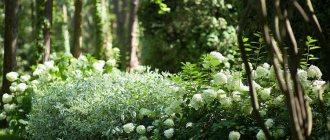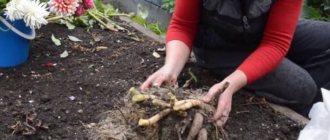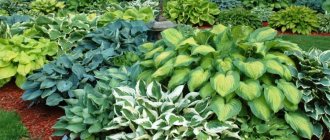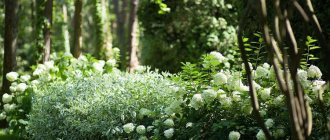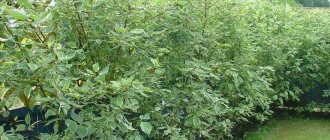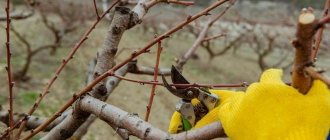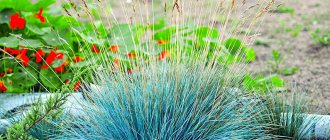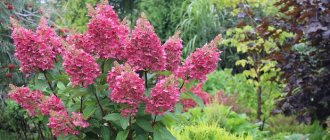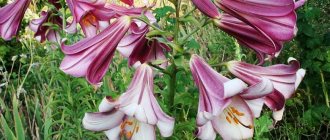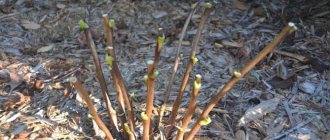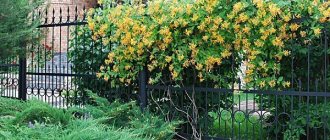Tips and questions
In the fall, gardeners still cannot afford proper rest. After all, it is necessary to properly prepare fruit trees for winter. It is very important to fertilize, pre-winter watering, clean the trunks and protect them from pests with whitewash. Some trees will need to be staked and covered. This whole set of measures is needed to ensure that the plants survive the frost well and begin to actively develop in the spring.
Trimming and cutting
In spring, old bushes are pruned to make it possible for new growth to appear. In this case, stumps are usually left 15-20 cm from the ground level. You can also remove old branches in the fall. But considering that white derain remains decorative all year round and in winter decorates the area with red shoots, picturesquely peeking out from under the snow, it is not advisable to do this.
White dogwood is a bush with a spreading crown. If it develops naturally, then the branches are located chaotically in different directions. To improve aesthetic perception, a bush is formed. Svidina is given various shapes, usually round or oval. Haircuts are carried out 2-3 times per season. The last time this procedure is carried out is at the end of July.
In summer, the bush develops very actively. In some species, growth reaches 50-60 cm per season. Therefore, in order to preserve decorative qualities, a haircut may be necessary.
How to prepare garden trees for winter
With the onset of autumn, gardeners have to put their garden area in proper shape by putting things in order and performing a whole range of important work. This is necessary so that the site does not just look attractive. Every year such events are held in order to properly prepare plants for the cold. Moreover, the future harvest depends on it.
The optimal time to clean the garden is mid-October. During this period, it is recommended to thoroughly inspect the trees and identify any damage. Also, this autumn month is suitable for harvesting the last harvest and removing all unnecessary fruits.
Note! You cannot leave carrion in the garden over the winter. It is recommended to dispose of rotten fruits by burying them in the ground, preferably outside the boundaries of the site.
Learning to grow white turf on your site
This insect loves to nibble the leaves of the plant. The female measures up to 1.5 mm, and the male – 0.5 mm. Females are covered with a shield, under which they store eggs during wintering on the trunks of bushes. If they have not died, then in April the larvae begin to emerge, which attach to the trunks and leaves, becoming densely covered with white threads. After two months, females emerge from them, and within a month they eat the entire bush, increasing in size by 2.5 times. Having laid eggs under the shell, they die.
In order for the eggs to be fertilized, males are needed, which are born quite rarely, and the eggs themselves become food for ticks, bedbugs, and spiders. You can get rid of this pest by treating the bushes with insecticides Decis, Kinmiks, Karbofos when the larvae emerge from under the shields. Another common turf pest is aphids. It usually settles on the underside of leaves, flower buds, and sometimes on stems. It has an oblong body up to 2 mm, long legs and sometimes wings. After fertilization, females lay eggs until they become larvae, and can do this several times.
Plants from it are already familiar with the peculiarities of the local climate, this contributes to rapid adaptation to a new place. When choosing a seedling, you must pay attention to the root system. It must be developed, the length of the tap root must be at least 20 cm. Dried and rotten roots are absent in healthy plants.
They should be flexible and creamy white or pale green when cut. The bark of such specimens is smooth, elastic, uniform in color, without spots suspiciously reminiscent of mold or rot. There is nothing complicated about planting a plant in the ground. Even a novice gardener can cope with this.
It is not much different from a similar procedure for other fruit trees and berry bushes. A newly planted variegated dogwood bush needs regular watering. Young specimens of variegated dogwood tolerate adaptation to new living conditions and the associated stress quite easily. But for adult plants the process is quite complicated.
A transplant is carried out only when it is impossible to do without it. For example, if the place for a bush is chosen extremely poorly, it oppresses other plantings, the leaves have lost the variegated color characteristic of the variety. In addition, it is problematic to remove an adult plant from the ground due to its developed root system. The plant is removed from the ground along with a lump of earth on the roots, trying to damage it as little as possible.
The diameter of the root system approximately coincides with the crown of the bush. The earthen lump should be carefully wrapped in polyethylene or burlap and moved to a new place.
After transplanting the turf, be sure to water it abundantly, and mulch the soil with humus mixed with peat chips. Instead of purchasing planting material, you can get it yourself if there are already specimens of variegated dogwood on the site.
The plant reproduces well both by vegetative cuttings, dividing the bush, rooting layering, and by generative seed germination.
It decorates the area with numerous light inflorescences, and after flowering the bush is covered with white or white-blue berries. In autumn, its leaves turn purple, and in winter, its red branches look stunning against the white snow. Therefore, it is often used to form a hedge on the site.
The last method of reproduction is the most labor-intensive and time-consuming. In addition, it is impossible to guarantee that the main varietal characteristic - the variegated color of the leaves - will be preserved.
Many gardeners do this.
Tree feeding: some tips
When the area is in order, you can begin the next stage of pre-winter garden preparation. The soil needs fertilizing. It is recommended to use potassium and phosphorus as fertilizers for fruit plants. Such nutritious “cocktails” will be especially useful for current year seedlings and young trees. Potassium sulfate and superphosphate are also suitable for them.
It is very important to remember which trees need feeding. Before wintering, it is worth saturating the soil with fertilizers around:
- cherries;
- apple trees;
- pears;
- drain;
- gooseberries;
- red and black currants;
- grapes
If there are roses and lilies in the garden, then you should not forget about them.
Any fertilizing is applied to the soil according to the scheme indicated on the product packaging. It is necessary to add useful substances to the tree trunk circles.
Preparing trees for winter: feeding
On a note! In autumn and late summer, it is recommended to spray trees with compounds that are essentially foliar fertilizers.
As for foliar fertilizers, the optimal solution is potassium monophosphate. This is an excellent complex product, enriched with valuable vitamins and minerals. These substances will help garden shrubs and trees properly prepare for frost. They also help strengthen trees.
Derain Elegantissima
But in order for the shrub to maintain its decorative appearance and develop normally, a minimum of time and effort will still have to be spent on it. The main thing the plant needs is regular pruning.
The turf tolerates the procedure well, even if the gardener overdoes it a little. An uncontrollably growing bush of variegated dogwood looks rather untidy. The first time pruning is carried out at the beginning of the third season after planting in open ground. No more than a third of all shoots are removed, leaving the most powerful and developed ones.
The dogwood bush tolerates pruning, including radical pruning, with virtually no damage. The procedure is carried out in early spring, before active sap flow begins, but always at above-zero temperatures.
The exception is the hedge, which is formed twice a year, in July and September. For this purpose, use exclusively clean, sharply sharpened and disinfected tools - knives, scissors, pruning shears.
As for the configuration, the gardener is limited solely by his own imagination. A variegated dogwood bush can be given any, the most incredible shape. Not least for this, landscape designers appreciate it.
Although many people prefer to simply slightly adjust the natural shape. Be sure to get rid of broken, leafless, dried, deformed, twisted shoots. Those that grow inwards, thickening the crown, or downwards also look bad. Their tissue cells have differences at the genetic level. Therefore, sometimes a gardener can find monochromatic green leaves on shrubs with initially variegated colors. They, along with the shoots, must be removed in a timely manner, because they are genetically stronger.
If you do not trim on time, soon the variegation will disappear altogether. Young plants and transplanted adult specimens require daily moderate watering during the first week after the procedure. In general, variegated turf can withstand drought and heat without much damage to itself. Powerful roots allow them to draw moisture from deep layers of soil.
Adult plants are watered at the root once a month. If there is intense heat for a long time and there is no precipitation, the intervals between procedures are reduced to 5-8 days. The water consumption rate is 20-25 l. By autumn, watering is gradually reduced. The variegated dogwood bush does not need frequent watering; the root system can easily provide the plant with everything it needs, including moisture. Fertilizing is applied twice during the growing season, in spring and autumn.
In the first case, complex mineral fertilizer containing nitrogen, phosphorus and potassium is used: Azofoska, Diammofoska, Nitrofoska. Enough for an adult plant.
Once every 3-4 years, you can add a bucket of humus or rotted compost under the bush, mixing it with the soil during the loosening process. In autumn, the tree needs phosphorus and potassium. A natural source of these macronutrients is wood ash. It is added to the roots in dry form if the weather is rainy.
Description of the tree
When there is no precipitation for a long time, prepare an infusion - a half-liter jar of raw materials per 3 liters of boiling water. You can also use complex fertilizers without nitrogen, for example, ABA, Autumn. During the active growing season, if desired, about once a month you can feed variegated dogwood bushes with natural organic matter. Infusions of fresh cow manure, chicken droppings, nettle greens, and dandelion leaves are suitable for this.
In general, any weeds growing in the garden can be used as raw materials. They are crushed and about a third of a deep container is filled. The remainder is added with water. The container is tightly closed and left in direct sunlight for several days.
Before use, it is filtered and diluted with water in proportion Photo from the hitsad website. The main advantage of this variety is its bright red bark, which looks impressive against the backdrop of snow in winter. The main advantage of this variety is its bright red bark.
Photo from cornishgardennurseries website. This is a large bush up to 2 meters high, with brown-red shoots. The leaves have an uneven and wide border of yellow color along the edges, turning purple in the fall. Photo from the flora-company website.
Derain Ivory Halo. A spreading bush up to 2.5 m high. The leaves are bluish-green with a white border, the variety is winter-hardy. Derain Elegantissima. Photo from the website cvety-prodazha. It’s a pity, it would be nice to see such a handsome man as Derain Kouza in your garden.
Flowering of the Couse tree. Photo from onlinetrees. All offers Store offers:. Other
Autumn watering: useful tips
Autumn watering is an important stage in preparing the garden for winter. If there is little rain during this period, then there is a high probability of the land drying out. This is why moisture-recharging irrigation is necessary for trees.
During this procedure, gardeners will need to correctly calculate the required amount of water for each “inhabitant” of the garden. To do this, you will need to take into account the total area of the site. For every 1 sq. meter should use an average of 50 liters of liquid. It is recommended to use fairly warm water. Its temperature should be approximately 5 degrees higher than ambient conditions.
If the plants are older than 5 years, it is recommended to water them along the periphery of the crown. Young individuals irrigate around the circumference of the trunk circle. In any case, it is worth working in stages. About 15-20 liters of water should be used in about 1 hour. The same should be done with the remaining volume of liquid required for the irrigated area.
Preparing trees for winter: autumn watering
Note! Gradual watering of garden shrubs will not allow moisture to stagnate.
To prevent the procedure from harming the roots of trees when watering through the holes, they should be filled in at the end of the event. For mulching you can use:
White dogwood: planting and caring for seedlings
- White dogwood can be planted with seeds in containers and seedlings can be obtained from them, suitable for growing in open ground. But it is better to use ready-made planting material. When purchasing it at retail outlets, it is important to inspect the plants for diseases and pests.
- Having determined the place for planting white deer, they dig a hole slightly larger in diameter than a lump of earth.
- A nutrient mixture consisting of humus, leaf soil, and mineral additives is poured into it. Since turf grows in one place for a long period of up to 25 years, at the beginning of growth it is necessary to provide it with nutrition, and then feed it.
- The hole is watered with water to compact the introduced soil.
- The seedling in the container is also watered and allowed to stand for 10-15 minutes to soak.
- Then it is taken out along with a lump of earth and carefully placed in a hole, trying not to disturb the root system.
- The hole with the young bush is covered with soil, compacted and watered abundantly.
If planting is carried out in the fall, then nothing else needs to be done. In spring, it is better to mulch the planting site to avoid moisture loss. During the summer, weeds are removed and the soil under the bush is loosened as much as possible. As it grows, the white dogwood itself destroys its harmful neighbors.
Spraying fruit trees: protection from rodents
A very important period of pre-winter preparation of trees for cold weather is pest control. In frosty weather, rodents can cause significant damage to plants. That is why it is necessary to properly formulate the protection of shrubs.
The simplest, but very effective method against rodents is winding. For this you can use:
However, it is best to use more reliable means. Winding against rodents using roofing felt, roofing felt, special plastic gratings or reed mats will be much more effective. These materials thoroughly prevent pests from accessing plants.
Types and varieties of derain
White derain - there are more than 20 varieties, popular almost everywhere. The most famous of them are:
- variegated derain elegantissima is one of the most famous winter-hardy bushes, growing up to 2.5 m, sometimes even up to 3 m in height. It has leaves of a bluish-green tone, bordered by a snow-white border, which will turn light pink by the beginning of autumn. Variegated dogwood planting and care for this species is similar to white dogwood;
- white Siberian derain - a shrub up to 1.5 m high has coral shoots and rich emerald foliage. The bark of the plant stands out with its unique beauty - it is bright scarlet in color, and mainly looks gorgeous in winter, against the backdrop of snow-white snow. The fruits are milky with a delicate blue tint;
- white Sibirica variegata - bushes 2 m high, with light emerald foliage with a white border, which by the beginning of autumn acquire a brownish-purple color. Withstands extreme frosts very well. A good option for small garden plots;
- white derain aurea - grows up to 2 m in height. It has the widest leaves among all types of crops. The brown-red leaves will become a soft yellow color during the growth stage. Blooms with creamy white inflorescences;
- white ivory derain Hal - the crop grows up to 2 m in height, with erect shoots of a scarlet-brown color, emerald foliage with snow-white veins and a frame, which turns scarlet-coffee color by autumn. Blooms with pleiochasia of yellowish flowers;
- white derain guhalti - related to deciduous bushes, can reach 2–3 m in height. The shoots-twigs are bright scarlet, the emerald crown with a yellowish and pinkish border, the berries are white and blue;
- derain white cream cracker - depending on the breeding conditions, it can grow from 80 cm to 3 m, foliage from 1 m to 2 m. The crimson-colored shoots are erect and arranged freely. Light emerald leaves with creamy stripes and edges. Young shoots with bright wheat leaves. It blooms with pleiochasia corymbs of cream flowers; small snow-white berries appear in the month of August.
Some spraying features
Spraying deserves special attention. This is an effective preventative measure to ensure tree health. The method copes well with fungal infections. Spraying is best done when leaf fall ends. This will allow the product to reach the branches and trunk.
It is optimal to treat trees with a solution of copper sulfate. It is necessary to use a 5% composition, which can be obtained by mixing 300 grams of the product in a bucket of water.
Spraying fruit trees against rodents
Note! Copper sulfate is best diluted with warm liquid, since the product does not dissolve well in cold water.
Cleaning and whitewashing of trees
It is equally important to clean and whiten the “inhabitants” of the garden. In order not to spoil the order in the area, a tarpaulin, thick fabric or oilcloth is spread around the trees. Old bark will fall onto this material. It is recommended to clean using a metal brush or scraper.
It is important to thoroughly treat all trunks from the bark, which has retreated greatly. You also need to clean all hard wounds, as they are real “gateways” for infections and bacteria.
The bark must be scraped off in layers, avoiding injury to living tissue. This event is necessary in order to increase gas exchange of adult plants and increase their viability. All peeled bark must be taken out of the garden and burned.
Some features of whitewashing
Autumn whitewashing is an effective protection of trunks. It helps protect crops from sunburn and pest attacks. The procedure can be carried out strictly after removal:
The lower part of the tree is treated with whitewash. It is recommended to go through the trunk to the base of the lower branches.
Preparing trees for winter: whitewashing
For work, you can use ready-made whitewash. The composition is also easy to prepare with your own hands. 500 grams of copper sulfate and 3 kg of lime need to be dissolved in 10 liters of water. You can add 200 grams of wood glue to the mixture. This component will help the whitewash last as long as possible.
White derain - care
This soil-undemanding and frost-resistant shrub is sufficient for a long time to nourish the minerals and organic matter added when planting the bush. When it comes to feeding, turf especially loves wood ash.
It is better to plant turf in a sunny area. If the soil at the planting site is clayey, then you need to arrange drainage in the planting hole, add humus and compost to the soil.
The turf bush should be regularly pruned for decorative purposes. The frequency of pruning depends on the type of shape being given.
White dogwood is not of interest to pests, and this reduces care for the plant to a minimum.
Tree tying and covering
Gartering and covering garden crops for the winter deserves special attention. Plants under 5 years of age are especially demanding. It is recommended to cover:
The procedure requires the use of special material. Straw, spruce branches, burlap, lutrasil and agrospan cover well.
First, you will need to construct a house from bars around a representative of the world of flora. A covering material is fixed on top of it and tied with twine. This measure allows you to protect only the crown. To prevent the root system from freezing, you should use peat or spruce branches.
Note! Some of the trees need supports. Apricots need to be tied up before winter. Support is also required for those seedlings that were planted in the ground only in the fall.
Preparing trees for winter: garter and shelter
Sheltering is carried out in other ways. You can use special shields or trample the tree trunk circles with snow.
White dogwood: planting and care in the garden
Like any plant, white dogwood needs to create certain conditions for development and growth.
Light
White dogwood is one of the ornamental shrubs that grow well in partial shade and shade. They are not very demanding of sunlight. Therefore, most often the plant is planted near blank walls and fences, under trees. The variegated foliage and brightly colored shoots of the tree look especially good against the background of the thick dark needles of spruce, thuja, and pine. However, to achieve the greatest decorative effect, the shrub should not be shaded too much.
Warm
Svidina, as white dogwood is also called, grows under natural conditions in the harsh climate of Siberia and the Far East. Cultivated species recommended for planting in garden or park areas have inherited resistance to severe frosts and sudden changes in air temperature. Therefore, gardeners may not specifically cover the shrub for the winter. You just need to lightly sprinkle it with snow and compact the “pillow”. In the cold season, derain is also good when bright red shoots are visible against a snow-white background.
The soil
The composition of the soil for growing dena does not matter much. The shrub develops well in any soil with a normal acidity level. It is one of the crops that can grow on heavy loams and light sandstones, on rocky areas. White dogwood tolerates the presence of lime in the soil well. Creating special soil fertility for pork is not required. Periodic application of complex mineral fertilizers will promote the development of beautiful foliage and shoots. But even if fertilizing is not carried out in a timely manner, the shrub will not lose its decorative effect.
Water
Under natural conditions, derain grows in humid and moderately humid places. It grows well along the banks of rivers and lakes. Therefore, on the site he will be at ease next to a pond or with those plants that are often watered. In hot weather, it should be watered generously at least once a week. At other times, the derain will have enough moisture from the soil and that which comes with precipitation.
Landing dates
White pigweed is planted in early spring or late autumn. Planting dates have almost no effect on the development of the shrub. However, it is better to do this before the onset of the cold period. With the onset of the first warmth, autumn plantings are activated and begin to grow vigorously; they do not require time to adapt to new conditions. In spring, it is recommended to plant plants with a large lump of earth in order to preserve the root system as much as possible.
Video: how to prepare your garden for winter
Source: house-dacha.ru
Derain is a favorite of designers
Belongs to the Derenny family. The Latin name translates as “horn”. Representatives of this genus have very durable, heavy wood. There are about 50 species, distributed in temperate regions of the Northern Hemisphere and one species each in South America and Central Africa.
These are mainly decorative deciduous, sometimes evergreen shrubs , less often trees, spectacular in the summer with their foliage and white flowers.
In autumn, they attract attention with white and blue fruits - drupes, pink or burgundy leaves. They are no less spectacular in winter, with colored shoots (depending on the type, bright red, burgundy, yellow or bright green). Due to its amazing beauty, it is often used by designers and landscape architects when creating various compositions.
Preparing for winter
A winter-hardy plant does not need preparation for winter.
They collected turf in the forest. Blue berries with a bluish tint. Tart in taste. True, the leaves were not as beautiful as in the photo
04/24/2016 at 17:16
Read in the section
A parasitic plant of the broomrape family, it belongs to the genus of achlorophyllous perennial or annual herbaceous plants. The family has more than 150 species, and the most common are 40. This diversity is explained by the wide range of plants that become hosts for broomrape. The most dangerous species are those that attack sunflower, fodder, vegetable and melon crops.
Eustoma (lat. Eustoma) or lisianthus (lat. Lisianthus), gentian family. Biennial herbaceous flowering plant with flowers of various shades, highly branched. It is grown both in open ground and at home.
A small evergreen tree of the Rutaceae family. In temperate latitudes it can only be cultivated in greenhouses, greenhouses and insulated balconies. In open ground it can reach a height of 3-5 meters.
Also known as fig, fig tree, fig tree, wineberry. Deciduous tropical plant of the genus Ficus. One of the most ancient cultivated plants. Produces sweet and high-calorie fruits.
A tall tree with large leaves and tasty, nutritious and healthy fruits. For medical purposes, not only the kernels of ripe nuts are collected, but also the shells of green and ripe fruits, partitions and even leaves.
Belongs to the Derbennikov family, a genus of shrub and medium-sized trees. The natural habitat of the pomegranate is the tropics and subtropics, but it is successfully cultivated in the Crimea, Asia and Transcaucasia.
A shrub up to 3.5 meters high with gray bark, drooping thin branches and thorns. It has small fruits with a diameter of up to 1.5 centimeters, which are not recommended to be consumed raw.
A tropical and subtropical evergreen tree with fleshy orange fruits that have a characteristic astringent taste. Persimmons are grown mainly in warm regions or indoors.
Vsadu.ru is a free online magazine about dachas, gardens and vegetable gardens.
- September 10, Tuesday
- Gardener's Calendar - September
- Question/Answer 1233
- News & Events
- Garden and vegetable garden Flowers and flower beds Trees and shrubs Indoor plants Home and garden Garden equipment Do-it-yourself Landscape design Health Food and Recipes Buy / Sell
- Plant catalog
- Diseases and pests
- Contacts
- Partners
- Vsadu.ru is an educational online magazine about dachas, gardens and vegetable gardens, a gardener’s calendar for every day, tips on caring for your garden and vegetable garden.
Free consultations on the construction of a townhouse, country house, cottage. Selection of equipment for a summer residence, landscaping, landscape design, selection of trees and shrubs, care of flowers and plants. Answers to questions, news, events, announcements of exhibitions and events. Recipes for delicious and healthy dishes and drinks made from vegetables, fruits and berries.
White dogwood is a wonderful ornamental shrub that gives a beautiful look to the garden at any time of the year. It decorates the area with numerous light inflorescences, and after flowering the bush is covered with white or white-blue berries.
In autumn, its leaves turn purple, and in winter, its red branches look stunning against the white snow. Therefore, it is often used to form a hedge on the site.
Derain white
One of the most common species in culture. In nature, it is found in floodplains, among bushes almost throughout Russia, as well as in China, Korea, and Japan.
Shrub up to 3 m tall, with thin flexible, mostly coral-red, less often red-brown or black-red branches. Young shoots usually have a bluish bloom. The leaves are dark green, bluish-white underneath, broadly ovate, slightly wrinkled, up to 10-12 cm long, turning purple-red in autumn. The flowers are small, white, collected in numerous corymbose inflorescences up to 5 cm in diameter. It blooms very profusely in the first half of summer and again in early autumn, when simultaneously with the flowers you can see mature, spherical, berry-shaped fruits of white color with a bluish tint. It begins to bloom and bear fruit at the age of 2-3 years.
Propagation of dogwood by cuttings in spring
The culture is very easily propagated by lateral layering, horse suckers and cuttings. The best time to take cuttings is at the end of the flowering cycle. A suitable stem should break when bent.
Cut cuttings with 2-3 internodes below the leaf buds at an angle of 45 degrees. It is better to remove the leaves. The lower part of the cuttings is first dipped in water and then in a hormone that stimulates root growth. Plant in a pot with a mixture of sand and perlite or universal soil and sand (1:1).
Spray water on the soil and cuttings and cover with a transparent bag. The pot is placed in a shady place in the garden. The formation of roots is possible by maintaining a constant average humidity of the substrate.
Rooting usually takes about 6 weeks. As soon as signs of new growth appear, the bag can be removed and the seedlings placed in a place with bright, indirect light.
Rooted cuttings
Water the plants regularly and use liquid fertilizer, but only half the dose. Grown seedlings with well-formed leaves and roots are transplanted into a larger pot with a fertile mixture and left for the winter in a cool room. Planted in open ground in late spring.
19 unpretentious flowering perennials
Wood cuttings can also be harvested in late autumn and stored in the refrigerator all winter in a closed bag with damp sand. In spring, the rooting technology is the same as described above.
Agricultural technology
Features of landing. Grows in sun and partial shade. The distance between plants in groups is 0.6-1.0 m.
Soil mixture : leaf soil, peat compost, humus (1:1:1). Sand is added to the top layer if the soil is clayey, or clay if the soil is light and sandy. Optimal soil acidity pH = 6.0-7.5. Drainage is optional.
Fertilizing is carried out with full mineral fertilizer Kemira-Universal in the spring at the rate of two matchboxes per 1 m2. In summer, humus or compost is added to the tree trunk circle (one bucket for each plant).
Watering . Although the crop is drought-resistant, it grows better in moist soils. Water it moderately - one bucket of water for each adult plant twice a month.
Haircut, trimming . Deren tolerates these operations well. In autumn and spring, old shoots are cut off and the crown is thinned out. In the spring, before the buds open, the first pruning is carried out. In this case, all annual growths are cut off, leaving 2-3 buds. The second pruning is carried out in mid-late June. It consists of pinching the tops of all regrown shoots. Partial pruning of faded shoots is also allowed in summer. Heavy pruning leads to intensive shoot growth.
Preparing for winter . Shelter is not required, since the plants are quite winter-hardy.
Reproduction . The turf is propagated by seeds, cuttings, root suckers, and layering. Seeds are sown after three months of stratification. The rooting rate of cuttings is 90% without treatment or 100% when treated with succinic acid (0.02%). Cultivars can be propagated by budding a dormant bud into the root collar of the main species.
Decorative turf - care after planting
Dera seedlings after planting are very sensitive to drought, so watering is carried out in the absence of rain once every 2 days for a month, and then over the next year they are watered abundantly once every 1 week, maintaining average soil moisture. In the summer heat, watering is increased.
Variegated turf in autumn, variety “Wolf's Eyes”
Mature 4-5 year old plantings can withstand short-term drought, but in conditions of prolonged absence of water the foliage withers and dries out. After abundant irrigation (2-4 buckets per bush), the elasticity of the leaves is restored. Irrigation in summer is best done in the evening, pouring water into the hole near the trunk.
Attention! Good growth and decorativeness of the crop are possible only with constant substrate moisture
Mulching the soil around plantings, especially young ones, will help prevent the evaporation of water from the soil and protect it from overheating in summer and cold in winter. Mulch from compost or peat is poured in a circle near the trunk, without touching the base of the shoots or the trunk.
Some varieties can freeze in cold winters, but Kousa turf is especially sensitive to cold. Young plants of this species need shelter made of non-woven material, and the roots are protected from a high layer of mulch from spruce branches or fallen leaves.
Caring for derain in the garden includes seasonal fertilizing. For good growth and flowering, feed with balanced slow-acting mineral fertilizers in the form of powder or granules.
Fertilize during the active growing season of shoots in May-June. In autumn, potassium fertilizing is relevant, increasing the plant’s resistance to low winter temperatures and diseases.
Protection from diseases and pests
Diseases. Powdery mildew. Spray with colloidal sulfur or a solution of soda ash and soap (0.4%). Spots on leaves. Spray with Bordeaux mixture. Gray rot on leaves and shoots. Spray with Vectra solution.
Pests . Green tree aphid, comma scale insect. Resistance to these pests increases with the application of mineral fertilizers and foliar fertilizing with microelements. Spraying with karbofos or decis is effective; an infusion of onion, thermopsis lanceolate, potato tops or a decoction of yarrow is also used.
